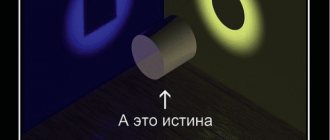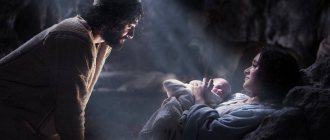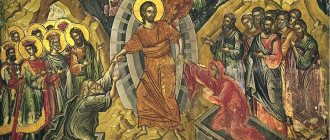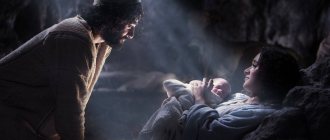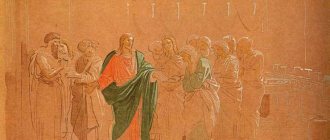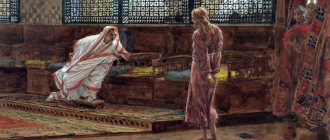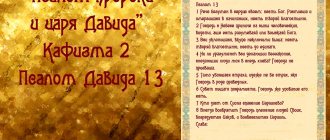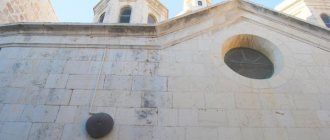What is truth?
In the name of the Father and the Son and the Holy Spirit.
The Gospel of John contains no descriptions of the Lord's suffering in Gethsemane. Although not long before them, the Lord, excited by the arrival of the pagans who wanted to see Him, was overwhelmed by the experiences of His impending death on the Cross: “The hour has come for the Son of Man to be glorified... My soul is now indignant; and what should I say? Father! deliver Me from this hour! But for this hour I have come” (John 12, 23, 27).
| Good Friday. Christ before Pilate. VI century Miniature of the Gospel from Rossano. Museum in Rossano, Italy |
Thus, the Gospel of John with particular force designates the victorious path of the Savior, with sovereign dignity maintaining power over all events.
The Lord Himself betrays Himself to those who came to take Him and demands that no one dare lay hands on His disciples. We see this absurd procession in the middle of the night, led by the traitor Judas, this detachment of Temple guards with lanterns, daggers and weapons. What do all their precautions mean? The Lord Himself comes out to meet them. He does not wait for the kiss of the hypocrite to point to Him and hand Him over to the high priests for punishment. Until this time, no one could take Him - neither the enthusiastic crowds who wanted to proclaim Him king (John 6:15), nor those sent from the high priests and Pharisees who came to take Him on the Feast of Tabernacles (John 8:20), nor the Jews intending to stone Him (John 8:59 and 10:31) “for His hour had not yet come.” Now His hour has come. The Lord accepts him. “The Lord is coming for a free Passion,” we confess during Holy Week. “Who are you looking for?” - the Lord asks them. They answer him: “Jesus the Nazarene.” The Lord says to them: “It is I.” We know what meaning the Gospel gives to these words of the Savior. “This is I”, “I am” - more often denotes the Divine Person and the Divine service of the Lord. “I am the one who existed from the beginning” (John 8:25), “I am the way, the truth, and the life” (John 14:6), “I am the good shepherd” (John 10:11), “I am the good shepherd” (John 10:11), “ I am the true vine” (John 15:1). Sometimes the Lord uses these words in an absolute meaning: “Before even Abraham was not, I am” (John 8:58). With the same words, God reveals Himself to Moses: “I am who I am” (Ex. 3:14).
Hearing the name of God, the enemies of the Lord retreated back and fell to the ground. In this event preceding the Passion of Christ, the Vanquished is the Victor. This is a sign of His Resurrection. The Lord freely betrays Himself, but He alone goes to His death. “Leave them alone, let them go,” He says of His disciples. He does not call them disciples, so as not to give a reason to accuse them. He only points his hand at them and forces their enemies to obey Him. Jesus Christ is the One who saves. And this is also a sign of Him.
However, Peter, filled with anger, forgetting all caution, tries to protect his Lord. He drew his sword and struck the high priest's servant and cut off his right ear. All four Gospels tell about this event, but only the Gospel of John gives the name of the one who did it - Peter, and only here the name of the high priest's servant is given - Malchus. He was probably specially sent by the high priest to oversee the execution of the operation to capture Christ.
The Lord addresses Peter with a word that also reminds us of Gethsemane, but which is heard at this moment in the Gospel of John: “Put your sword in its sheath; Shall I not drink the cup that the Father has given me?” The Lord wants the disciples to understand that all resistance is useless, that He is fulfilling the will of the Father.
Only the Gospel of John mentions the judgment of the Lord by the former high priest and father-in-law of Caiaphas, Anna. Annas was high priest from 6 to 15 A.D., one of his sons succeeded him for a short period (from 15 to 18), then he was succeeded by Caiaphas, who remained in this position until 37. Further high priests were successively four sons of Anna, as well as one of his grandsons. Much evidence has been preserved of the close family ties of many high priestly families. They held in their hands not only religious, but also political power, as well as untold wealth. Herod the Great was very jealous of the influence of the high priests - often he even killed them and members of their families. Caiaphas probably ordered Christ to be brought first to his father-in-law in order to pay him his respects and establish his authority.
Christ is asked about His teaching. With the greatest dignity, the Lord refers them to reliable evidence that could be presented here so that a genuine trial could take place, and not an ominous parody of it, where everything was decided in advance. It is impressive that by saying: “I have always taught in the synagogue and in the temple, where Jews always meet” (John 18:20), the Lord is addressing the testimony of history, to everyone in the human race who hears His gospel.
Further, in a few words, the trial of Caiaphas is mentioned. The Gospel of John does not report the meeting of the Sanhedrin, but does give a detailed description of Pilate's trial. We are faced with the terrible paradox of this situation. Two powers come face to face - the power that Pilate represents, that is, the Roman Empire, and the power that Christ, who came from above, possesses, and without which Pilate is nothing. Two powers and two justices: one wavering and, in the end, unjust - the Roman procurator and the other, sovereign - the Lord, who reads in the minds and hearts and judges His judge: “He who delivered Me to you has more sin.” And finally, truth and lies come face to face. The Lord affirms Himself as the herald of truth, the One who reveals the revelation of truth. He Himself is the truth, the one that is with God.
Pilate's question: “What is truth?” filled with anxiety and confusion. Pilate is not that stupid. He is convinced of the innocence of Christ. He talks about it openly. But how to convince the screaming crowd and accusers from the Sanhedrin of this? The Roman procurator lacks the courage to go all the way in bearing witness to the truth. (Note that the Lord is not talking about those who possess the truth, but about those who are of the truth, for the truth is a good that surpasses everything and everyone). But the Jews, for their part, continue to attack Christ with a blatant lie: “If He had not been a villain, we would not have handed Him over to you.” “If you let Him go, you are not Caesar’s friend; “Everyone who makes himself a king is an opponent of Caesar.”
And the lie wins: “We have no king except Caesar.” In fact, they think completely the opposite; they cherish one hope - that a leader will appear among them who will free them from the Roman yoke. If Christ had been such a seducer, a revolutionary calling for the political liberation of Israel, they would never have handed Him over to Pilate! But the height of the hypocrisy of the members of the Sanhedrin, already before the trial, was when they refused to enter inside Pilate’s palace in order to be clean before eating the Passover lamb. While Christ, having entered the house of the uncircumcised, becomes “unclean” for them. Thus, those who commit the most terrible of all crimes in the history of mankind call themselves undefiled.
Throughout the interrogation, the Lord remains completely calm. Pilate, on the contrary, is seized with anxiety and nervousness - he leaves the praetorium three times to the Sanhedrin and the crowd, and three times returns to Christ, trying to penetrate the mystery of His Person. The central theme of the dialogue, as in the Synoptic Gospels, is political: did the Accused One call Himself a king? Pilate can condemn Him only if the answer is positive. The Lord says: “My kingdom is not of this world.” Such a Kingdom cannot compete with the Roman Empire. Pilate is satisfied. But the maddened crowd understands everything in its own way and demands the death of the Lord and the release of Barabbas.
Pilate subjects the Lord to scourging, either to intimidate Him, or to arouse pity among the Jews. Scourging, crowning with thorns, dressing in purple, mocking soldiers - all this in the Gospel of John occurs during the trial. The question whether Christ is a king, the first accusation brought against Him, ends with the presentation of a foolish king with a crown of thorns, from which blood streams down His face. And the red robe of Christ is a sign of His victory.
“Behold, man,” says Pilate. The Gospel of John is the revelation of the mystery of the Incarnation. With terrifying truthfulness it testifies to the utmost humility of God who became man. But by this sorrowful path the Son of Man ascends to glory.
However, the high priests do not know pity: “Crucify, crucify Him!” And since the accusation of Christ’s encroachment on the kingdom turns out to be insufficient to sway the procurator, they throw their own accusation - the only word of truth that sounds here from their lips: “We have a law, and according to our law He must die, because He made Himself the Son God's." This time Pilate is truly alarmed. He experiences a kind of religious fear. He asks Christ: “Where are you from?” “But Jesus gave him no answer.” From that time on, Pilate sought to release Him. He makes another try. He brings Christ before the people onto a stone platform and, sitting at the judgment seat, in a place called Liphostroton, and in Hebrew Gavvatha, says to the Jews: “Behold, your King!” In response, only angry screams and threats are heard to appeal to Caesar, and Pilate gives in powerlessly, fearing denunciation to Rome.
“Then it was the Friday before Easter, and it was six o’clock.” We are given an exact indication of the time. The Jewish Passover begins on the evening of Christ's death on the Cross (days were counted from sunset). After six o'clock, that is, after noon, the Lord ascends to Golgotha. He breathed his last on the Cross at the hour when the Passover lamb was sacrificed in the Temple. He is the Lamb of the new Passover, slain for the salvation of all.
Three details stand out in the Gospel of John in the narration of the crucifixion and death of the Lord: the mention of an untied tunic, the words of the Lord addressed to His Mother, and the blow of a Roman soldier with a spear. The Apostle John the Theologian solemnly affirms the testimony of his Gospel: he saw water and blood flowing from the Savior’s rib pierced by a spear. Of course, it is not just the physical phenomenon, but its theological significance that interests the evangelist. This supreme gift of Christ is His final gospel. Water is a symbol of life. And just like blood. It contains the beginning of life. The Lord died to give life. From now on, Divine life will be poured out in abundance through the sacraments of the Church, primarily through Baptism and the Eucharist. We remember how in his First Catholic Epistle the Apostle John the Theologian speaks of “three witnesses” - blood, water and spirit. In addition, water in the language of Holy Scripture is a symbol of the Holy Spirit and spiritual life.
The soldiers struck the side of Christ with a spear to make sure of His death. They did not break His bones. The Gospel recalls the word of prophecy about the Passover lamb: “Let not his bone be broken” (Num. 9:12). Christ is the Passover Lamb. He feeds us with Himself in the Eucharistic gift, which precedes His free slaughter. So that we are always united with the Source of our life.
According to the law, the clothes of the executed could be divided among the executioners. There were four of them. And they divided the garments of the Lord into four parts, one for each soldier. “The tunic was not sewn, but entirely woven on top.” The Gospel of John mentions this because wearing an unsewn tunic was the distinction of the high priest during the divine service of the Old Testament feast, prefiguring the forgiveness of the sins of the entire people. Apart from Hebrews, this is the only place in the New Testament where the eternal high priestly ministry of the Lord is so clearly indicated.
Before the exodus, the Lord turns to His Mother. “Wife! Behold, Your son! - He says, pointing to the disciple whom He loved. As in Cana of Galilee, the Lord says to His Mother: “Woman!” “Then he says to the disciple: Behold, your Mother!” The Lord entrusts His Mother to John. His gaze is directed further - to His Church. He says to His Mother: “Woman” as in Cana of Galilee, because He calls Her to a service that surpasses Her human motherhood - what was already revealed in Cana of Galilee.
The Holy Apostle John the Theologian is the only one of the disciples who was faithful to the Lord to the end. He is the one who is Faithful, he is the Church. The Mother of God is entrusted with boundless spiritual Motherhood. That is why the Lord begins His ministry with the participation of His Mother. And at the end of the journey, in Filial sorrow, He passes Her on to his beloved disciple. So that each of us can address Her as Our Mother.
The truth about who we are and the truth about who Jesus is.
The Word of God is the truth. The Word became flesh and He dwelt among us. Therefore, the truth is the life of Jesus, which must be revealed in us. (2 Cor. 4:10) When we compare His life with our own lives and see how different they are from each other, it is as if a light goes on before us. Truth is the light that illuminates our lives and reveals who we are by nature. The light shows us the path we must take to be transformed into the image of Jesus. (Rom. 8:29)
The first step on the path of truth is taken when Jesus shines His light on our lives and we admit that we are sinners and need forgiveness, redemption and justification. This leads us to repentance.
The next step is that He shows us that even though we have been forgiven, sin still lives in our flesh, and we must recognize that on our own we cannot overcome when we are tempted to sin, which is so rooted in us - people. When we humble ourselves and acknowledge the truth about ourselves, then the Holy Spirit can fill us, enlighten us, guide us, and give us the strength and strengthening we need to do all that God has commanded us. we can give up our own will and do His will instead. In other words, we can have victory over the lusts of the flesh that lead to sin.
“We also know that the Son of God has come and given us light and understanding, so that we may know the true God and may be in His true Son Jesus Christ. This is the true God and eternal life.” 1 John 5:20.
Read also: How we can deceive ourselves and how to avoid it.
